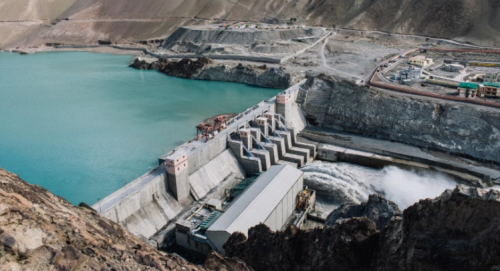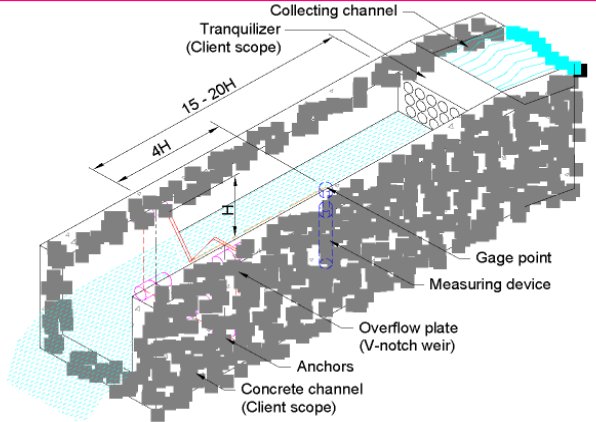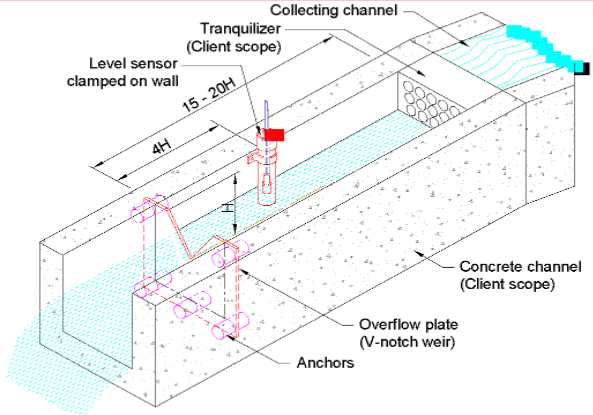Seepage of water through dams is quite common as almost all dams have some kind of seepage issue. This is due to the fact that reserved or retained water often seeps by the dam and its foundations.
Seepage monitoring is quite critical for the safety of the dam, because over time, if not properly channeled, seepage can become a serious threat.

Need and Importance of Seepage Monitoring
While analyzing the structural behavior of a dam, the quantity of seepage, the seepage path, and the velocity of seepage water are vital.
Need for Monitoring Quantity of Seepage

A huge quantity of seepage around, under, and through the dam can result in the dissolution of either the chemical constituents of the rock or soil material present at the locations. We have several dams that are founded on evaporites such as gypsum that can get affected by it. This can enlarge the path for seepage which in turn can cause bigger dissolution. The larger the dam is, the greater the chances of dissolution are there.
When a large amount of water moves around or under a dam, both soil and rocks become saturated in the seepage areas. It also results in excessive hydrostatic uplift pressure which weakens and softens the soil and rocks.
The storage capacity of the reservoir becomes compromised when an excessive amount of seepage happens.
Importance of the Seepage Location
Locating the seepage becomes vital as there can be a case where the seepage is in a discrete and remote area. The seepage velocity can be high, which can cause erosion of particles of soil. This will result in piping-type failure of the dam.
A high quantity of seepage in a few concentrated paths can cause concentrated dissolution in that area.
Importance of Velocity of Movement
The occurrence of piping failure will be more likely if the large particles are moved. This will only happen if the seepage velocity/water flow is high. The larger the velocity, the greater the chances of erosion in the seepage path.
How to Monitor Seepage in Dams
The quantity of seepage entering a seepage collection system is generally directly related to the level of the water in the reservoir. There are various methods to measure the seepage in dams.
Method 1: Calibrated Catch Container
This method is primarily for low-quantity seepage. It is one of the simplest methods to monitor the rate and flow of seepage. The drain water should be connected in either of the two ways.
The first way is that the drain water is directed through a pipe with an open end. In the latter, the drain water is directed through a constructed channel with an overhang and a vertical drop. The calibrated catch container is then placed in a position to catch the water and the time required to do so is measured with a stopwatch. The catch container should preferably be made of stainless steel or some suitable plastic material that does not corrode easily.
Method 2: Flow Meter
The seepage water is collected in a drain trench or toe drain and is discharged downstream of the dam via an open channel/pipe. In such a case, the quantity of flow is determined by measuring the velocity of the water. The thought leader, Encardio Rite, provides ultrasonic flow meters for monitoring the water flow/seepage.
Method 3: Weir

As one of the earliest, simplest, and most effective methods to measure the flow of water, this device stands the test against time. The material used to make the weir plate is stainless steel. The size is adjusted according to the expected flow of water. The weir uses the principle of the flow of water over the V-shaped plate.

The world leader, Encardio Rite, provides Model ESM-10 weir. Different shapes and sizes are available based on the client’s needs. The readings and measurements can be collected manually, via staff gauge or fixed stainless steel scale, or through the digital seepage monitoring system.
Monitoring Solutions Offered
Encardio Rite is a world leader in providing geotechnical instrumentation. We provide accurate and reliable data along with world-class technological instruments.
Digital Seepage Monitoring System
The purpose of the digital monitoring system is to get precise monitoring data, in near real-time, for the seepage or water flow in dams and open channels. To measure the discharge over the weir, Encardio Rite offers its precisely engineered digital seepage monitoring system, the Model ESM-12S.

The system comprises a low-range digital pressure sensor, datalogger, moisture trap, and perforated pipe. The sensor is positioned lower than the vertex of the weir. It measures the change in the water level/water head. To prevent the water level from being disturbed by turbulence like waves and vibration, the level head is measured in the collection channel. To compensate for the barometric variation automatically, the sensor is vented to the atmosphere with a vented signal cable.

The digital pressure sensor is connected to a datalogger for online monitoring. Encardio Rite offers some of the latest data loggers in the business. Their datalogger Model ESDL-30 is a compactly designed device that can be easily attached near any sensor or in a control room. The datalogger has provision for wireless data transfer to the central server via GSM/GPRS.
The ESM-12S digital seepage system can also be connected with Node and Gateway for wireless data transfer via RF (radio frequency) communication networks.

Real-Time Data Analysis and Presentation
Encardio Rite has an in-house-developed data management software called Drishti. It is a single platform for comprehensive project data. Its purpose is to process and manage the project site’s data for further assessment and evaluation.
Drishti is a powerful tool, with very low downtime, that gives the user complete control of their project data with site-specific graphs and table forms. Its interactive user interface automatically handles the database interactions. It can be accessed via devices that support web browsers such as smartphones, laptops, desktops, and tablets.
The real-time data is accessible to all stakeholders 24X7, with instant alarms on critical events. The early warnings help in taking timely corrective action to prevent damages and minimize delays and operational costs.
Drishti has advanced features like Google Maps, georeference, graph zooming, dynamic graphs, outlier screening, accessibility to historical data, and so much more with single clicks.
It becomes very important to check and monitor the dams as these structures become a vital source of water supply. With our, world-class services, Encardio Rite offers comprehensive but easy-to-use instrumentation schemes for seepage monitoring that prove to be cost-effective as well.